Maria and I received this email from James in Korea with a new tangle he deconstructed. We are thrilled to share James' new tangle — and his story behind it — here with you all.
Dear Rick and Maria,
This is new tangle that I created. I want to share my appreciation with you about the journey from the rise of inspiration to completing the tangle.

New tangle prototype by James Lim CZT
This tangle is inspired by the pattern of windows and doors called Salchang (the lattice window of traditional Korean houses).

Traditional Korean house : Korea cultural heritage administration homepage
Salchang is a traditional Korean window and door made of thin woven wood with traditional Korean paper pasted on it. The wooden lattice is mainly made from the pine tree, and various patterns come out depending on how they are laid out.
I always thought that the pattern of traditional Korean windows and doors was great, and from a few years ago, I wanted to make a tangle with this pattern of the Salchang. I repeated my research whenever I had time. But when I drew it, I realized that I was just portraying the actual Salchang patterns. It wasn't easy to deconstruct it into a tangle. However, I always kept the pattern of the Salchang in my heart.
But a few days ago, the words of you and Maria suddenly came to my mind, shaking my head. "If you can write your name, you can do the Zentangle method!"
"If you can write your name… !"
Suddenly, at that very point, it seemed like the stagnant creativity found its way to an eruption. One part of my head that was thinking about the pattern of Salchang and the other part that remembered your words were connected at some point, and the light was shining. Is this the flow of creativity you were talking about?
If you can write your name... !
When you learn the Korean alphabet, Hangul, you learn "ㄱ(giyeok)" and "ㄴ(nieun)" first. "ㄱ" and "ㄴ" can be said to be "A" and "B" in the English alphabet. The inspiration from the traditional windows was amplified by the stories you regularly told, reminding me of "ㄱ" and "ㄴ". When my thoughts reached even the C-curve that connects the two letters, the pattern quickly deconstructed.

Korean alphabet: National Institute of Korean Language
The traditional window pattern that has been hovering around for few years was born into a new tangle, consisting of only "ㄱ" and "ㄴ" and C curves, in just a few hours.
[Comment: Maria and I love the gentleness that the curve brings to the angles of the corners . . . and the meta patterns that take shape as this tangle takes form.]
It was a fantastic experience where inspiration, creativity, passion, and understanding of the Zentangle philosophy were not independently separated from each other but influenced each other and melted together into one new creation in an instant.

Original by Ungto CZT and variation by Yunji CZT
I would like to express my sincere gratitude and respect to you and Maria for making this experience possible. The Zentangle Method makes our lives comfortable and happy and constantly stimulates creativity. In particular, this experience was a moment when I felt the meaning of creativity that you have always spoken of, and it was a very happy and thrilling moment. Thank you so much.
The name of the new tangle is “Ganada(가나다)”.
Ganada is a word with a vowel (a) added to the Hangul consonants “ㄱ” and “ㄴ“. It is the first word to follow when learning Hangeul, like the English “ABC”. It also contains the meaning that the Zentangle Method is easy to learn.
I particularly like this tangle because the simple strokes are repeated, it is difficult to understand how it was drawn after it is finished, and it can be transformed into various shapes.

Ganada tangle variation by Yunji and Ungto CZT

Ganada ( 가나다 ) tangle stepout
Rick adds:
I was immediately “drawn” to this tangle. Perhaps it is the mix of straight and curved lines in a structured approach with dynamic and unexpected results.
Here are some tiles that this tangle inspired.

At the top is my “getting familiar with the tangle” tile. Doing that gave me an idea of introducing auras of the underlying structure in a “static” format.
In the second tile I explored that approach further.
In the third tile, the phi tile, brown and black microns emphasize the two interweaving elements.
Thank you for the joy and new avenues of creative expression this brought to me and will bring to all the Zentangle community. I look forward to what people will create with it.




Kathy Y. on